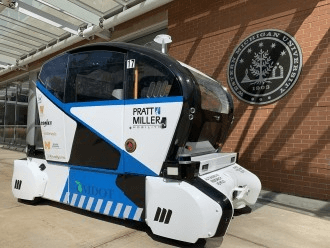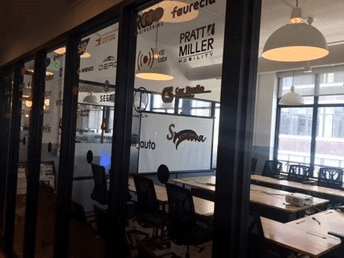Pratt Miller along with the MEDC, MDOT/PlanetM, and WMU Focus Mobility Efforts on Students with Disabilities
New Hudson, MI – October 23, 2019 – Western Michigan University (WMU) hosted Michigan’s Lt. Governor, Garlin Gilchrist, along with many other government officials earlier this week to view and ride in an automated shuttle funded under the $8 Million Michigan Mobility Challenge.
For the shuttle portion of the program, Pratt Miller Mobility partnered with academia and industry to use technology and innovation to solve mobility gaps, which is the overarching goal of the $8 Million Michigan Mobility Challenge. These industry-leading partners Robotic Research, Comet Mobility, Western Michigan University, University of Michigan, and Easterseals worked with the Pratt & Miller Mobility teams to address vehicle designs, mobility, autonomy, and system integration, accessibility, environment mapping, trip request and planning, and software development.
“We were thrilled to be selected by the MEDC/PlanetM and MDOT to lead the automated shuttle program,” said Christopher Andrews, Pratt Miller Director of Mobility. “Our team embraced the challenge. We brainstormed with a panel of students with disabilities to address a variety of concerns and implemented the best solution possible. The learnings from this program will inform the design of future vehicles to accommodate all people. There is still a lot of work to do to ensure equity, dignity, and mobility for all, and PME plans to be at the forefront of these efforts.”
Government officials, who were able to take one of the first rides in the shuttle, exited the vehicle with great reviews. “It was smooth,” said Lt. Governor Gilchrist. “We made some pretty tight turns and passed pedestrians without any issues.”
During the event the Lt. Governor was able to meet with students with disabilities attending the event. “I was so impressed with the amount of time he [Gilchrist] spent with the students,” said Andrews. “This type of interaction is why this event was so important. Our government officials must understand the issues folks with disabilities contend with—we can absolutely do better for this large portion of the population.”
About Pratt Miller
Pratt Miller is a product development company that through technology and innovation, solves customers’ most technical and complex challenges in the Motorsports, Defense, and Mobility industries.
Media Inquiries Please Contact:
Chris Andrews
313-300-1259
candrews@prattmiller.com













